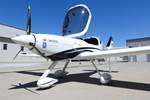Bye Aerospace closes $10 million in funding
The investments have enabled the company to work on Serial #001, the first production-conforming prototype of its two-seat eFlyer 2 aircraft.

Source | Bye Aerospace
Bye Aerospace (Denver, Colo., U.S.), developer of the FAA FAR 23-certified all-electric eFlyer aircraft, announced on July 13 the completion of a $5 million strategic investment by a venture capital group earlier this year. The successful investment was soon followed by the completion of a $5 million venture raise, reaching $10 million in total funding. George E. Bye, CEO of Bye Aerospace, says the investments have allowed the company to begin work on Serial #001, the first production-conforming prototype of its two-seat eFlyer 2 aircraft.
“Electric flight is the future of air travel, and even more so now following the coronavirus outbreak, especially as the demand for affordable, smaller, greener aircraft increases. We are seeing more investors recognize the vision of Bye Aerospace as a leader in this sector,” notes Chrysanthe Gussis, a Bay Area green tech investor, finance expert and a member of Bye Aerospace’s strategic advisory board.
Bye notes that although the two financial transactions successfully closed during coronavirus restrictions, much of the due diligence and planning was completed before the COVID-19 pandemic escalated. “Since raising the $10 million, we have completed critical design review in early June and are now underway with multiple test flights of the eFlyer 2 technology demonstrator,” he says. “Next, we will be solidifying our supply chain relationships to begin assembly on Serial #001.”
Previously, in late 2018, Bye Aerospace completed a major investment by SUBARU-SBI Innovation Fund, a joint venture between Subaru and SBI Investment Co. (Tokyo, Japan).
Related Content
-
AZL opens new project in cell-to-pack composite battery enclosures
AZL specialists are to kick off new project consortium Oct. 27, 2022 geared toward developing new battery enclosure concepts for cell-to-pack technology. Interested companies can still apply for participation.
-
Troubleshooting thermal design of composite battery enclosures
Materials, electrical insulation and certification are all important factors to consider when optimizing electric battery performance against potential thermal runaway.
-
Hankuk, Carbon, Dymag partner to scale up manufacturing of state-of-the-art carbon fiber wheels
Hybrid-composite BX-F wheels will serve high-performance road cars, luxury EVs and large SUVs and pickups.









.jpg;maxWidth=300;quality=90)



